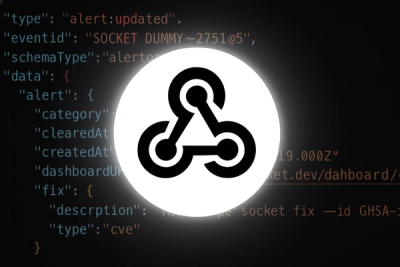
Research
/Security News
Shai Hulud Strikes Again (v2)
Another wave of Shai-Hulud campaign has hit npm with more than 500 packages and 700+ versions affected.
mouseOnly, touchOnly, or hybridmouse or touchmouse, touch, or key inputDetect It's state is determined using multiple media query and API detections. Detect It uses the hover and pointer media queries, the Pointer Events API and max touch points detections, and two Touch Events API detections (browsers respond differently to each Touch Events API detection depending on the device 😩 welcome to WebDev). But now you don't have to worry about any of this, just let Detect It handle the details while you optimize your app for the type of device that's being used. 😁
Detect It has been tested on numerous real world devices (since 2016), and the tests mock multiple devices and edge cases to ensure accurate results. The detection relies on how the browser presents the capabilities of the device as it is not possible to access the device hardware directly.
CDN option ⚡️ Recommended usage ⚡️ Device responsive UX ⚡️ Setting event listeners ⚡️ Detection details
npm install --save detect-it
import * as detectIt from 'detect-it';
// OR
import {
deviceType,
primaryInput,
supportsPointerEvents,
supportsTouchEvents,
supportsPassiveEvents,
} from 'detect-it';
// types
deviceType: 'mouseOnly' | 'touchOnly' | 'hybrid';
primaryInput: 'mouse' | 'touch';
supportsPointerEvents: boolean;
supportsTouchEvents: boolean;
supportsPassiveEvents: boolean;
deviceTypemouseOnly | touchOnly | hybrid
Indicates if the the device is mouseOnly, touchOnly or hybrid. For info on how the detection works and how specific devices are classified see the Detection details section.
import { deviceType } from 'detect-it';
if (deviceType === 'hybrid') {
// ensure the site is usable by both mouse and touch input
}
primaryInputmouse | touch
Indicates if the primary input for the device is mouse or touch. For more info on how to use primaryInput see the Recommended usage section.
import { primaryInput } from 'detect-it';
if (primaryInput === 'touch') {
// tailor UX for touch input
} else {
// tailor UX for mouse input
}
supportsPointerEventsboolean
Indicates if the browser supports the Pointer Events API. See MDN's Pointer Events and the W3C Pointer Events specification for more information on Pointer Events. See Can I use for current support.
import { supportsPointerEvents } from 'detect-it';
if (supportsPointerEvents) {
element.addEventListener('pointerenter', handlePointerEnter, false);
}
supportsTouchEventsboolean
Indicates if the browser supports the Touch Events API. See MDN's Touch Events and the W3C Touch Events specification for more information on Touch Events.
import { supportsTouchEvents } from 'detect-it';
if (supportsTouchEvents) {
element.addEventListener('touchstart', handleTouchStart, false);
}
supportsPassiveEventsboolean
Indicates if the browser supports passive event listeners. See this Passive Events Explainer for more information on passive events. See Can I use for current support.
import { supportsPassiveEvents } from 'detect-it';
if (supportsPassiveEvents) {
// passive events are supported by the browser
document.addEventListener('scroll', handleScroll, {
capture: false,
passive: true,
});
} else {
// passive events are not supported by the browser
document.addEventListener('scroll', handleScroll, false);
}
Optionally, instead of using npm install you can load Detect It directly in the browser. A minified and production ready UMD version is available from the Unpkg CDN for this purpose.
<!-- in index.html -->
<script src="https://unpkg.com/detect-it@4/dist/detect-it.umd.production.js"></script>
// it will be available on the window as DetectIt
if (window.DetectIt.primaryInput === 'touch') {
// tailor UX for touch input
}
TL;DR:
primaryInput to optimize the user experience for either mouse or touch input (note that the app should still be usable by both inputs). Use this along with classic responsive design that adapts to screen/window size to create a fully device responsive app.supportsPointerEvents then only set Pointer Event listeners and use pointerType to determine if the interaction was from mouse or touch.Device responsive UX is about creating web apps that feel native on every device. This goes beyond classic responsive design, which only responds to the screen/window size, and includes how the user can interact with the app (the capabilities of the device). Can the user hover, swipe, long press, etc?
There are 3 parts of device responsive UX: Size (size of screen/window), Capabilities (what the user can do/capabilities of the device), and Interaction (is the user hovering, touching, etc). Size and Capabilities need to be known at render time (when the UI is rendered before the user interacts with it), and Interaction needs to be known at interaction time (when the user is interacting with the app).
(max-width: 600px), either applied via CSS or in JavaScript by using something like React Media.deviceType or primaryInput to optimize the UX for the capabilities of the device, however, in most cases I've found it makes sense to just use primaryInput and optimize the UX for mouse or touch, while ensuring that the app is still usable by both inputs.primaryInput mouse: desktop/laptop with a normal windowprimaryInput mouse: desktop/laptop with a narrow windowprimaryInput touch: tabletprimaryInput touch: phonehover, mouseActive, touchActive, keyActive) and allows you to style touch interactions in a way that feels native and is not possible with CSS pseudo classes.Setting event listeners can be thought of as either setting Pointer Event listeners or setting Mouse Event and Touch Event listeners. Pointer Events can do everything that Mouse Events and Touch Events can do (and more), without having to worry about if a Mouse Event was caused by touch input and so should be ignored. It is generally preferred to use Pointer Events if they are supported.
If the browser supportsPointerEvents then only set Pointer Event listeners and use pointerType to determine if the interaction was from mouse or touch.
import { supportsPointerEvents } from 'detect-it';
const handlePointerEnter = (e) => {
if (e.pointerType === 'mouse') {
// event from mouse input
} else {
// event from touch input
// note that pointerType can be 'mouse', 'touch' or 'pen'
// but in most situations it makes it makes sense to treat 'touch' and 'pen' as the same
}
};
if (supportsPointerEvents) {
element.addEventListener('pointerenter', handlePointerEnter, false);
} else {
// set mouse and touch event listeners
}
If the browser doesn't support Pointer Events, then there are a couple of ways to approach setting mouse and touch event listeners.
Note that a touch interaction will fire Touch Events as the interaction is in progress (touch on the screen), and will fire Mouse Events during a long press (extended touch on the screen), or after the touch interaction has finished (after the touch is removed from the screen) to support sites that only listen for Mouse Events.
Option 1: If the device is mouseOnly or touchOnly then only set mouse or touch listeners, and if the device is hybrid set both mouse and touch event listeners and ignore Mouse Events caused by touch input (you can use Event From for this).
Option 2: Always set both mouse and touch event listeners and use Event From to ignore Mouse Events from touch input.
I prefer option 2 as it's simpler to code and I haven't noticed any performance impact from setting extra listeners (note that setting Touch Event listeners on a browser that doesn't support Touch Events is fine, the browser will just ignore the event listeners).
import { supportsPointerEvents } from 'detect-it';
import { eventFrom } from 'event-from';
const handleMouseEnter = (e) => {
if (eventFrom(e) !== 'mouse') return;
// code for handling mouse enter event from mouse input
};
const handleTouchStart = (e) => {
// code for handling touch start from touch input
};
if (supportsPointerEvents) {
// set pointer event listeners
} else {
// Pointer Events are not supported so set both Mouse Event and Touch Event listeners
element.addEventListener('mouseenter', handleMouseEnter, false);
element.addEventListener('touchstart', handleTouchStart, false);
}
deviceType and primaryInputTo determine the deviceType and primaryInput Detect It uses several media query and API detections to triangulate what type of device is being used. The entire detection is done when the script is imported so the results are known at render time (Detect It doesn't set any event listeners).
Detect It uses the hover and pointer media queries, the Pointer Events API and max touch points detections, and two Touch Events API detections (browsers respond differently to each Touch Events API detection depending on the device). For more on this see the comments in the source code for notes about detecting the device type and edge cases.
Detect It has been tested on numerous real world devices (since 2016), and the tests mock multiple devices and edge cases to ensure accurate results. However, these detections are limited by how the browser presents the capabilities of the device (the APIs it exposes and how it responds to media queries) so there are some limitations. For example, on an iPad it is impossible to tell if a mouse is connected, so Detect It always treats iPads as a hybrid device with primaryInput touch.
In the case of a legacy browser or device that doesn't support the detections (e.g. no media query or Pointer Events support), Detect It will fall back to a default mouseOnly or touchOnly state.
Detect It has a wide definition for what constitutes a hybrid device, or rather a strict definition for what are mouseOnly and touchOnly devices, because if a device strays from only a fine point and hover with a mouse, or a coarse touch with a finger, then it should be treated uniquely when considering how the user will interact with it. Below is the source code for determining deviceType:
// a hybrid device is one that both hasTouch and
// any input can hover or has a fine pointer, or the primary pointer is not coarse
// if it's not a hybrid, then if it hasTouch it's touchOnly, otherwise it's mouseOnly
export const deviceType =
hasTouch && (hasAnyHoverOrAnyFinePointer || !hasCoarsePrimaryPointer)
? 'hybrid'
: hasTouch
? 'touchOnly'
: 'mouseOnly';
hybrid device exampleshybrid with primaryInput touch)The detect-touch package is a lightweight library that focuses on detecting touch capabilities of a device. It is simpler and more focused compared to detect-it, which offers a broader range of input detection features.
Bowser is a browser detection library that can identify the browser, its version, and the operating system. While it does not specifically focus on input methods like detect-it, it provides comprehensive information about the user's environment.
Mobile-detect is a user-agent parser that can detect mobile devices, tablets, and their operating systems. It offers broader device detection capabilities compared to detect-it, which is more focused on input methods.
FAQs
Detect if a device is mouse only, touch only, or hybrid
The npm package detect-it receives a total of 234,439 weekly downloads. As such, detect-it popularity was classified as popular.
We found that detect-it demonstrated a not healthy version release cadence and project activity because the last version was released a year ago. It has 1 open source maintainer collaborating on the project.
Did you know?

Socket for GitHub automatically highlights issues in each pull request and monitors the health of all your open source dependencies. Discover the contents of your packages and block harmful activity before you install or update your dependencies.

Research
/Security News
Another wave of Shai-Hulud campaign has hit npm with more than 500 packages and 700+ versions affected.

Product
Add real-time Socket webhook events to your workflows to automatically receive software supply chain alert changes in real time.

Security News
ENISA has become a CVE Program Root, giving the EU a central authority for coordinating vulnerability reporting, disclosure, and cross-border response.